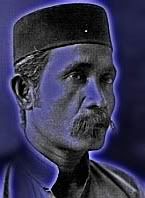Sheikh Ibrahim Alamudi hailed from Egypt, according to the notice board erected near his grave, and in 1899, when British anthropologist William Skeat visited him, perhaps after hearing about his exploits, he found no flags at the shrine,
"...but incense was apparently burnt there, and a goat sacrificed by the old care taker every Friday. The grave had five posts (batu nesan) at each end, making ten in all, instead of the usual single post, the superfluous ones had been added out of the funds provided by the saint's many devotees. To them also, presumably, was due the fact that it was protected by a triple mosquito curtain, and an atap roof-shelter was built over it."
In later times, misguided people went to Sheikh Ibrahim to make offerings, or to seek the departed saint’s intercession for some
hajat (desires), to ask for guidance on lottery numbers, and a little notice there now says it is forbidden to bury placentas by this graveside. The living have strange notions of the dead.
Sheikh Ibrahim al-Amudi’s resting place is now protected by a concrete vault, and you’d have to be very tall to peek through the slots just beneath its roof to peek into the deep dark. Its wooden door is permanently padlocked, and all is quiet around him, within crumbling walls that was once quite grand, covering an enclosed area where many prominent people of Trengganu were laid to rest. Not far from the Sheikh is the grave of Sultan Baginda Omar, under whose reign the Sheikh lived. Sheikh Ibrahim died on 18th August 1873, and the Sultan, barely three years after that.
Here, in this haven of peace there’s much to glean about Trengganu’s past. The decorations on tall grave stones that speak in another voice of another place, in shapes and curls reminiscent of the Langkasuka motif, or voices etched in weathered stones of journeys past in mists of time. When I touched the weathered stone I felt the moss and the night’s dew or was that the wetness of the ocean spray that drenched body and soul of sea-faring men who braved the rise and rolls of Nusantara storms?
Sheikh Ibrahim could well have been the man who walked the beach when British naval boats were bombarding our shore (but Awang, see
Comments below, thinks that it could have been another man known as Tok Ku Paloh — real name Sayyid Abdul Rahman bin Sayyid Muhammad bin Sayyid Zainal Abidin al-Eidrus — a contemporary of Sheikh Ibrahim and another prominent figure in Trengganu’s early resistance against the British). But I raised this question in my last posting: which ex Sultan sought refuge in Trengganu and why did the Maharaja of Johor ask the British to bombard Trengganu's coast?
In “They Came to Malaya”, an absorbing collection of extracts from writings on Malaya from pre to post colonial times, historian John Gullick added this footnote to Skeat’s mention of the Trengganu bombardment by ‘the Maharaja of Johore’:
“It was the British navy which had bombarded Kuala Trengganu in 1862, not the Maharaja of Johore.”
When I wrote to him to say what I found in British newspaper reports on the attack, Gullick wrote back:
“The Maharaja of Johor had good reason to promote the expulsion of ex-Sultan Mahmud from Trengganu. Until Raffles in effect divided the Rhio Johor kingdom in 1819 by recognising a separate ruler of Singapore and Johor, Johor was part of a kingdom of which Mahmud had later been ruler until deposed by the Dutch. If Mahmud could regain his primacy throughout the entire traditional kingdom of Rhio-Johor that would demolish the Maharaja's plans for securing recognition as an indepedent ruler of Johor.”
So who was this ex Sultan Mahmud of Rhio (Riau) Johor? I shall continue this story later.
Labels: John Gullick, Raffles, Sheikh Ibrahim al-Amudi, Sultan Baginda Omar, Sultan Mahmud of Rhio-Johor, Tok Ku Paloh, William Skeat


